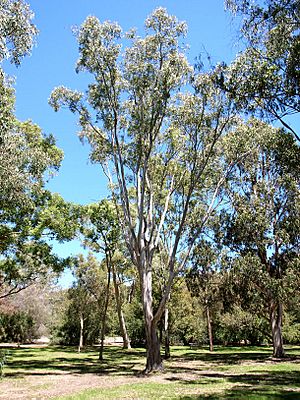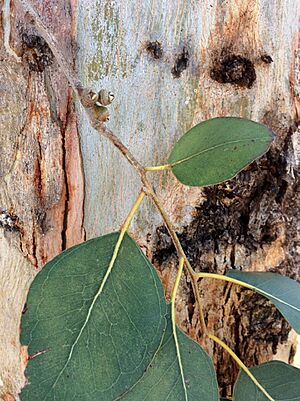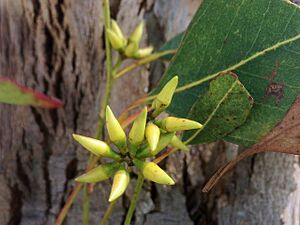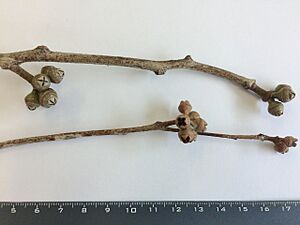Cabbage gum facts for kids
Quick facts for kids Cabbage gum |
|
|---|---|
 |
|
| A Cabbage Gum tree in the ANBG | |
| Conservation status | |
| Scientific classification | |
| Genus: |
Eucalyptus
|
| Species: |
amplifolia
|
The Eucalyptus amplifolia, often called the cabbage gum, is a tree found only in eastern Australia. It has smooth bark on its trunk and branches. Its leaves are shaped like a spear. The tree produces buds in groups of seven to fifteen or more. Its flowers are white, and its fruit are round, woody capsules. This tree is common in the coastal areas and tablelands of New South Wales. It also grows in nearby parts of southeastern Queensland, reaching as far south as Bega.
Contents
What Does the Cabbage Gum Look Like?
The Cabbage Gum is a tree that can grow up to 30 m (100 ft) tall in forests. In more open woodlands, it is often shorter.
Its Bark and Leaves
This tree has smooth bark that can be many colors. It might be white, cream, yellow, grey, pink, or blue-grey. Sometimes, you'll see loose, flaky grey pieces of bark at the bottom of the trunk.
Young Cabbage Gum plants have round or egg-shaped leaves. These leaves are green and can be quite large. Adult leaves are arranged one after another along the stem. They are broadly spear-shaped, measuring up to 250 mm (10 in) long. The leaves are a dull or shiny green on both sides.
Its Flowers and Fruit
The Cabbage Gum's flowers grow in groups of seven to fifteen or more. These groups are on a flattened stem about 7–15 mm (0.3–0.6 in) long. The buds are shaped like a cone.
The tree usually flowers between November and January. After flowering, it produces woody, round fruits. These fruits are about 2–5 mm (0.08–0.2 in) long and 4–6 mm (0.16–0.24 in) wide. Each fruit has three or four small parts that point upwards.
How the Cabbage Gum Got Its Name
The scientific name for the Cabbage Gum is Eucalyptus amplifolia. It was first officially described in 1891 by a scientist named Charles Victor Naudin.
The name amplifolia comes from two Latin words. Amplus means "large," and folium means "leaf." So, amplifolia means "large-leaved," which describes the big leaves of this eucalypt.
Scientists have also identified two types, or subspecies, of Eucalyptus amplifolia:
- Eucalyptus amplifolia subsp. amplifolia: This type has buds and fruit that grow on a small stalk.
- Eucalyptus amplifolia subsp. sessiliflora: This type does not have a distinct stalk for its buds and fruit.
Where Does the Cabbage Gum Grow?
The Cabbage Gum grows in grassy woodlands and forests. You often find it in low areas or on flat land near rivers.
Where to Find Subspecies amplifolia
The amplifolia subspecies is found on the coastal plains of New South Wales. It grows from Taree down to Batemans Bay. You can also find some groups of these trees further north near Coffs Harbour. They also grow in the Megalong Valley and on the Southern Tablelands near Goulburn.
Where to Find Subspecies sessiliflora
The sessiliflora subspecies grows in northern New South Wales. It is found in areas like Tenterfield, Armidale, and Casino. It also grows in nearby parts of Queensland.
Images for kids
- Features of the cabbage gum (''Eucalyptus amplifolia'')
-
A eucalyptus forest near Prospect Creek in Sydney, containing some cabbage gum trees.











